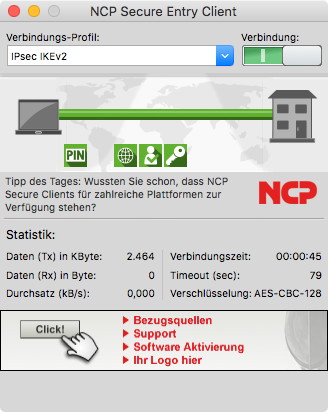Ncp For Mac
3d home for mac os x 10.7. If you are looking for Free Vpn Software Download For Mac And Ncp Vpn Client Soft. Little snitch for mac os.

- Alternatives to NCP Secure Entry for Windows, Mac, Android, iPhone, Linux and more. Filter by license to discover only free or Open Source alternatives. This list contains a total of 25+ apps similar to NCP Secure Entry. List updated: 9/11/2020 3:56:00 PM.
- Ncp free download - NCP, NCP Mobile, NCP Authenticator, and many more programs. All Windows Mac iOS Android. Editor Rating & up & up & up & up.
Resolution
Overview
The NCP Secure Entry Client is an IPsec-compliant third-party application that can be used to establish a connection to a GlobalProtect Gateway using either a PSK or certificates with XAUTH. Versions are currently available for Windows, Mac OS X, and Android operating systems. The instructions below pertain to the Windows client and assume that the GlobalProtect Gateway has already been configured on the Palo Alto Networks firewall. Bridge for mac wifi. Otherwise, refer to How to Configure GlobalProtect.
Steps
- Open the NCP Secure Entry Client and go to Configuration > Profiles.
- Click the Add / Import button.
- Choose the Connection Type.
Select Link to Corporate Network Using IPsec.
- Choose the Profile Name. Enter an alphanumeric name for the connection profile.
- Choose the Communication Medium. Select the proper Communication Media depending on how the client connects to the internet. The two most common options are LAN (over IP) for Ethernet and Wi-Fi for wireless connections. The NCP client will automatically select the connection media if automatic media detection is selected.
- Set the VPN Gateway Parameters.
Gateway (Tunnel Endpoint): the DNS name or IP address of the GlobalProtect Gateway configured on the Palo Alto Networks firewall.
Check the Extended Authentication (XAUTH) box. Enter a User ID and Password that can be authenticated by the Palo Alto Networks firewall.
- IPsec Configuration.
Exchange Mode. For PSK authentication, select aggressive mode (IKEv1).
For certificate authentication, select main mode (IKEv1).
PFS Group: none

Pre-shared Key
Local Identity (IKE):
For PSK authentication:
Type: select Free string used to identify groups.
ID: enter the Group Name configured under Network > GlobalProtect Gateways > Client Configuration on the Palo Alto Networks firewall.
For certificate authentication:
Type: select ASN1 Distinguished Name.
ID: leave this field blank.
Pre-shared Key (required for PSK authentication only):
Shared Secret: enter the Group Password configured under Network > GlobalProtect Gateways > Client Configuration on the Palo Alto Networks firewall. The configuration for PSK authentication is shown below.
- Configure the IP Addresses
IP Address Assignment: select IKE Config Mode.
Don't modify the DNS Server or WINS Server fields.
- Set up the Firewall. Select the desired Stateful Inspection setting and click the Finish button.
If using PSK authentication, the configuration is complete and you should be able to connect to GlobalProtect Gateway.
Ncp Manchester
- Export the root and client certificate from Device > Certificate Management > Certificates on the Palo Alto Networks firewall.
Note: This step is not necessary if an external CA is used, but the root certificate must be DER encoded and the client certificate must be in the PKCS#12 format.
Export the root certificate in the Binary Encoded Certificate (DER) format.
In the NCP client, go to Configuration > Certificates.
Click the Add button.
User Certificate
Name: enter a name for the certificate configuration.
Certificate: select from PKCS#12 file.
PCKS#12 Filename: browse to the client certificate exported from the Palo Alto Networks firewall.
(optional) Check the PIN Request at each Connection box if you want the user to enter the client certificate Passphrase before every connection attempt.
Click the OK button.
- In the left menu, select Identities.
- Certificate Configuration: select the certificate configuration you created earlier.
- Click the OK button.

17. Move the exported root certificate into the NCP > SecureClient > CaCerts directory. The default installation path is C:Program Files (x86)NCPSecureClientCaCerts.
You should now be able to use the NCP client to connect to the GlobalProtect Gateway using certificates and XAUTH.